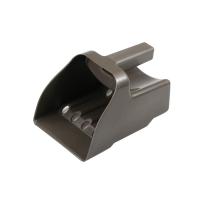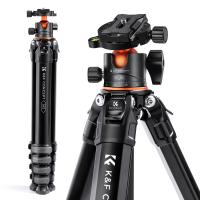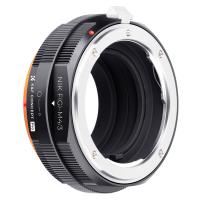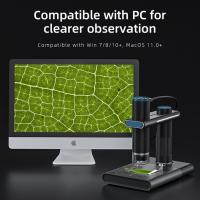What Are Microscopes Made Of ?
Microscopes are typically made of a combination of materials, including metal, glass, and plastic. The main structural components of a microscope, such as the base, frame, and stage, are often made of metal, such as aluminum or stainless steel, to provide stability and durability. The lenses and objectives of a microscope are made of high-quality glass, which is carefully shaped and polished to achieve the desired magnification and clarity. Additionally, the eyepiece or ocular lens, which is the part through which the viewer looks, is also made of glass. Some parts of a microscope, such as the focusing knobs or stage clips, may be made of plastic for ease of use and cost-effectiveness. Overall, the materials used in microscopes are chosen to ensure optimal performance, precision, and longevity.
1、 Optical components (lenses, prisms) for magnification and focusing.
Microscopes are essential tools used in various scientific fields to observe and study objects that are too small to be seen with the naked eye. They are made up of several components that work together to magnify and focus the image being observed. The primary components of a microscope are the optical components, which include lenses and prisms.
Lenses are crucial in microscopes as they help magnify the image of the specimen being observed. They are typically made of high-quality glass or plastic and are carefully shaped to bend and focus light rays. The objective lens, located near the specimen, collects and magnifies the light that passes through it. The eyepiece lens, on the other hand, further magnifies the image for the viewer's eye.
Prisms are another important component of microscopes, particularly in compound microscopes. They are used to redirect and manipulate light, allowing for better image quality and clarity. Prisms, such as the Abbe condenser, help focus the light onto the specimen, enhancing the contrast and resolution of the image.
In recent years, there have been advancements in microscope technology, leading to the development of more sophisticated optical components. For instance, there has been a growing interest in using advanced materials, such as metamaterials, in the construction of lenses. Metamaterials have unique properties that can manipulate light in unconventional ways, potentially leading to improved resolution and magnification capabilities.
Additionally, there have been advancements in the field of microscopy that go beyond traditional optical components. Techniques such as electron microscopy and scanning probe microscopy have revolutionized the way we observe and study objects at the nanoscale. These techniques utilize electron beams or atomic force probes to create highly detailed images with exceptional resolution.
In conclusion, microscopes are primarily made of optical components such as lenses and prisms, which are crucial for magnification and focusing. However, with advancements in materials and techniques, the field of microscopy continues to evolve, offering new possibilities for observing and understanding the microscopic world.
2、 Mechanical framework (metal, plastic) for stability and adjustment.
Microscopes are essential tools used in various scientific fields to observe and study objects that are too small to be seen with the naked eye. They are made up of several components, each serving a specific purpose. One of the key components of a microscope is the mechanical framework, which provides stability and allows for adjustment.
The mechanical framework of a microscope is typically made of metal or plastic. Metal frames, such as aluminum or stainless steel, are commonly used in high-quality microscopes due to their durability and stability. Plastic frames, on the other hand, are often found in lower-cost microscopes and are suitable for less demanding applications.
The mechanical framework serves as the foundation for the microscope and holds all the other components in place. It provides stability to ensure that the microscope remains steady during observations, preventing any unwanted vibrations or movements that could affect the accuracy of the results.
Additionally, the mechanical framework allows for adjustment of various components, such as the stage, focus knobs, and objective lenses. These adjustments are crucial for achieving precise focusing and positioning of the specimen under observation. The framework also includes mechanisms for controlling the illumination source, such as the condenser and diaphragm, which are essential for optimizing the quality of the image.
In recent years, there have been advancements in microscope design, with the introduction of materials such as carbon fiber-reinforced polymers. These materials offer improved strength-to-weight ratios, making microscopes lighter and more portable without compromising stability. Furthermore, the use of 3D printing technology has allowed for the creation of customized and intricate parts, enhancing the overall functionality and versatility of microscopes.
In conclusion, the mechanical framework of microscopes is typically made of metal or plastic and provides stability and adjustment capabilities. Advancements in materials and manufacturing techniques have further improved the design and functionality of microscopes, making them indispensable tools in scientific research and discovery.
3、 Illumination system (LED, halogen) for lighting the specimen.
Microscopes are complex instruments that are made up of several components, each serving a specific purpose to enhance the visualization of microscopic specimens. While there are various types of microscopes, they generally share some common elements.
One of the essential components of a microscope is the illumination system. This system provides the necessary light to illuminate the specimen being observed. In modern microscopes, the illumination system typically consists of LED (Light Emitting Diode) or halogen lights. LED lights have gained popularity in recent years due to their energy efficiency, longer lifespan, and ability to produce bright and uniform illumination. They also emit less heat, which is beneficial for delicate specimens that may be sensitive to temperature changes. Halogen lights, on the other hand, have been traditionally used in microscopes and provide a bright and intense light source. However, they tend to generate more heat and have a shorter lifespan compared to LEDs.
In addition to the illumination system, microscopes are made of other important components such as lenses, eyepieces, objectives, and stages. Lenses, including the eyepiece and objective lenses, are crucial for magnifying the specimen and focusing the light onto it. The stage holds the specimen in place and allows for precise movement and positioning. The body of the microscope is typically made of metal or plastic, providing stability and durability.
Advancements in technology have also led to the development of more sophisticated microscopes, such as electron microscopes and confocal microscopes. These instruments utilize different principles and components, including electron beams and laser systems, to achieve higher magnification and resolution.
In conclusion, microscopes are made of various components, with the illumination system being one of the key elements. LED and halogen lights are commonly used in modern microscopes to provide adequate illumination for observing specimens. However, it is important to note that the specific components and materials used in microscopes may vary depending on the type and purpose of the microscope.
4、 Stage and specimen holder for positioning and stability.
Microscopes are complex instruments that are made up of several components, each serving a specific purpose to enable the observation of tiny objects and structures. While there are various types of microscopes, including optical, electron, and scanning probe microscopes, they all share some common elements.
One essential component of a microscope is the stage and specimen holder. This part provides a platform for positioning and stability of the specimen being observed. The stage typically consists of a flat surface where the specimen is placed, and it can be adjusted in different directions to achieve the desired viewing angle. The specimen holder, on the other hand, securely holds the specimen in place to prevent any movement during observation.
The materials used to construct the stage and specimen holder can vary depending on the type of microscope and its intended application. In optical microscopes, the stage is often made of metal or glass, providing a sturdy and stable platform. The specimen holder may be made of plastic or metal, designed to securely hold the specimen without interfering with the observation.
In recent years, there have been advancements in microscope technology, leading to the development of more specialized stages and specimen holders. For example, some microscopes now incorporate motorized stages that allow for precise and automated positioning of the specimen. This enables researchers to easily navigate through large samples or create detailed maps of microscopic structures.
Additionally, there has been a growing interest in developing stages and specimen holders that can accommodate live specimens, such as cells or small organisms. These specialized holders often incorporate environmental control features, such as temperature and humidity regulation, to maintain optimal conditions for the specimen's viability during observation.
In conclusion, the stage and specimen holder of a microscope play a crucial role in providing stability and positioning for the specimen being observed. The materials used in their construction can vary, but they are designed to ensure accurate and controlled observation. With advancements in technology, there have been developments in motorized stages and specialized holders for live specimens, enhancing the capabilities of modern microscopes.




























There are no comments for this blog.